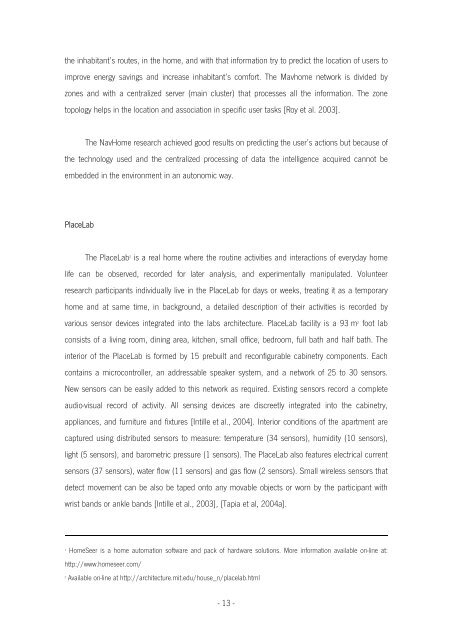Carlos Manuel Rodrigues Machado Autonomic Ubiquitous Computing
Carlos Manuel Rodrigues Machado Autonomic Ubiquitous Computing
Carlos Manuel Rodrigues Machado Autonomic Ubiquitous Computing
Sie wollen auch ein ePaper? Erhöhen Sie die Reichweite Ihrer Titel.
YUMPU macht aus Druck-PDFs automatisch weboptimierte ePaper, die Google liebt.
the inhabitant’s routes, in the home, and with that information try to predict the location of users to<br />
improve energy savings and increase inhabitant’s comfort. The Mavhome network is divided by<br />
zones and with a centralized server (main cluster) that processes all the information. The zone<br />
topology helps in the location and association in specific user tasks [Roy et al. 2003].<br />
The NavHome research achieved good results on predicting the user’s actions but because of<br />
the technology used and the centralized processing of data the intelligence acquired cannot be<br />
embedded in the environment in an autonomic way.<br />
PlaceLab<br />
The PlaceLab 2 is a real home where the routine activities and interactions of everyday home<br />
life can be observed, recorded for later analysis, and experimentally manipulated. Volunteer<br />
research participants individually live in the PlaceLab for days or weeks, treating it as a temporary<br />
home and at same time, in background, a detailed description of their activities is recorded by<br />
various sensor devices integrated into the labs architecture. PlaceLab facility is a 93 m 2 foot lab<br />
consists of a living room, dining area, kitchen, small office, bedroom, full bath and half bath. The<br />
interior of the PlaceLab is formed by 15 prebuilt and reconfigurable cabinetry components. Each<br />
contains a microcontroller, an addressable speaker system, and a network of 25 to 30 sensors.<br />
New sensors can be easily added to this network as required. Existing sensors record a complete<br />
audio-visual record of activity. All sensing devices are discreetly integrated into the cabinetry,<br />
appliances, and furniture and fixtures [Intille et al., 2004]. Interior conditions of the apartment are<br />
captured using distributed sensors to measure: temperature (34 sensors), humidity (10 sensors),<br />
light (5 sensors), and barometric pressure (1 sensors). The PlaceLab also features electrical current<br />
sensors (37 sensors), water flow (11 sensors) and gas flow (2 sensors). Small wireless sensors that<br />
detect movement can be also be taped onto any movable objects or worn by the participant with<br />
wrist bands or ankle bands [Intille et al., 2003], [Tapia et al, 2004a].<br />
1 HomeSeer is a home automation software and pack of hardware solutions. More information available on-line at:<br />
http://www.homeseer.com/<br />
2 Available on-line at http://architecture.mit.edu/house_n/placelab.html<br />
- 13 -

















